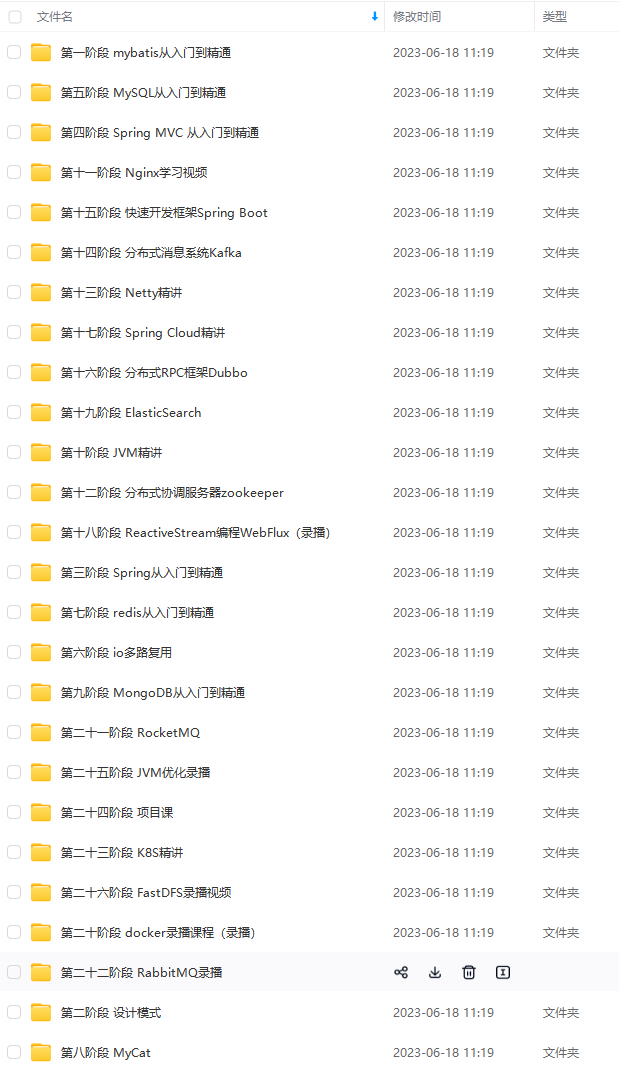public void testConcat() {
System.out.println(“>>> testConcat() <<<”);
String str = “”;
long start = System.currentTimeMillis();
for (int i = 0; i < max; i++) {
str = str.concat(“a”);
}
long end = System.currentTimeMillis();
long cost = end - start;
System.out.println(" {str.concat(“a”)} cost=" + cost + " ms");
}
public void testJoin() {
System.out.println(“>>> testJoin() <<<”);
long start = System.currentTimeMillis();
List list = new ArrayList();
for (int i = 0; i < max; i++) {
list.add(“a”);
}
long end1 = System.currentTimeMillis();
long cost1 = end1 - start;
StringUtils.join(list, “”);
long end = System.currentTimeMillis();
long cost = end - end1;
System.out.println(" {list.add(“a”)} cost1=" + cost1 + " ms");
System.out.println(" {StringUtils.join(list, “”)} cost=" + cost
+ " ms");
}
public void testStringBuffer() {
System.out.println(“>>> testStringBuffer() <<<”);
long start = System.currentTimeMillis();
StringBuffer strBuffer = new StringBuffer();
for (int i = 0; i < max; i++) {
strBuffer.append(“a”);
}
strBuffer.toString();
long end = System.currentTimeMillis();
long cost = end - start;
System.out.println(" {strBuffer.append(“a”)} cost=" + cost + " ms");
}
public void testStringBuilder() {
System.out.println(“>>> testStringBuilder() <<<”);
long start = System.currentTimeMillis();
StringBuilder strBuilder = new StringBuilder();
for (int i = 0; i < max; i++) {
strBuilder.append(“a”);
}
strBuilder.toString();
long end = System.currentTimeMillis();
long cost = end - start;
System.out
.println(" {strBuilder.append(“a”)} cost=" + cost + " ms");
}
}
> 测试结果:
- 执行100次, private static final int max = 100;
testPlus() <<<
{str + “a”} cost=0 ms
testConcat() <<<
{str.concat(“a”)} cost=0 ms
testJoin() <<<
{list.add(“a”)} cost1=0 ms
{StringUtils.join(list, “”)} cost=20 ms
testStringBuffer() <<<
{strBuffer.append(“a”)} cost=0 ms
testStringBuilder() <<<
{strBuilder.append(“a”)} cost=0 ms
- 执行1000次, private static final int max = 1000;
testPlus() <<<
{str + “a”} cost=10 ms
testConcat() <<<
{str.concat(“a”)} cost=0 ms
testJoin() <<<
{list.add(“a”)} cost1=0 ms
{StringUtils.join(list, “”)} cost=20 ms
testStringBuffer() <<<
{strBuffer.append(“a”)} cost=0 ms
testStringBuilder() <<<
{strBuilder.append(“a”)} cost=0 ms
- 执行1万次, private static final int max = 10000;
testPlus() <<<
{str + “a”} cost=150 ms
testConcat() <<<
{str.concat(“a”)} cost=70 ms
testJoin() <<<
{list.add(“a”)} cost1=0 ms
{StringUtils.join(list, “”)} cost=30 ms
testStringBuffer() <<<
{strBuffer.append(“a”)} cost=0 ms
testStringBuilder() <<<
{strBuilder.append(“a”)} cost=0 ms
- 执行10万次, private static final int max = 100000;
testPlus() <<<
{str + “a”} cost=4198 ms
testConcat() <<<
{str.concat(“a”)} cost=1862 ms
testJoin() <<<
{list.add(“a”)} cost1=21 ms
{StringUtils.join(list, “”)} cost=49 ms
testStringBuffer() <<<
{strBuffer.append(“a”)} cost=10 ms
testStringBuilder() <<<
{strBuilder.append(“a”)} cost=10 ms
- 执行20万次, private static final int max = 200000;
testPlus() <<<
{str + “a”} cost=17196 ms
testConcat() <<<
{str.concat(“a”)} cost=7653 ms
testJoin() <<<
{list.add(“a”)} cost1=20 ms
{StringUtils.join(list, “”)} cost=51 ms
testStringBuffer() <<<
{strBuffer.append(“a”)} cost=20 ms
testStringBuilder() <<<
{strBuilder.append(“a”)} cost=16 ms
- 执行50万次, private static final int max = 500000;
testPlus() <<<
{str + “a”} cost=124693 ms
testConcat() <<<
{str.concat(“a”)} cost=49439 ms
testJoin() <<<
{list.add(“a”)} cost1=21 ms
{StringUtils.join(list, “”)} cost=50 ms
testStringBuffer() <<<
{strBuffer.append(“a”)} cost=20 ms
testStringBuilder() <<<
{strBuilder.append(“a”)} cost=10 ms
- 执行90万次, private static final int max = 900000;
testPlus() <<<
{str + “a”} cost=456739 ms
testConcat() <<<
{str.concat(“a”)} cost=186252 ms
testJoin() <<<
{list.add(“a”)} cost1=20 ms
{StringUtils.join(list, “”)} cost=68 ms
testStringBuffer() <<<
{strBuffer.append(“a”)} cost=30 ms
testStringBuilder() <<<
{strBuilder.append(“a”)} cost=24 ms
> 查看源代码,以及简单分析
String contact 和 StringBuffer,StringBuilder 的源代码都可以在Java库里找到,有空可以研究研究。
- 其实每次调用contact()方法就是一次数组的拷贝,虽然在内存中是处理都是原子性操作,速度非常快,但是,最后的return语句会创建一个新String对象,限制了concat方法的速度。
public String concat(String str) {
int otherLen = str.length();
if (otherLen == 0) {
return this;
}
int len = value.length;
char buf[] = Arrays.copyOf(value, len + otherLen);
str.getChars(buf, len);
return new String(buf, true);
}
- StringBuffer 和 StringBuilder 的append方法都继承自AbstractStringBuilder,整个逻辑都只做字符数组的加长,拷贝,到最后也不会创建新的String对象,所以速度很快,完成拼接处理后在程序中用strBuffer.toString()来得到最终的字符串。
/**
* Appends the specified string to this character sequence.
*
* The characters of the {@code String} argument are appended, in
* order, increasing the length of this sequence by the length of the
* argument. If {@code str} is {@code null}, then the four
* characters {@code “null”} are appended.
*
* Let n be the length of this character sequence just prior to
* execution of the {@code append} method. Then the character at
* index k in the new character sequence is equal to the character
* at index k in the old character sequence, if k is less
* than n; otherwise, it is equal to the character at index
* k-n in the argument {@code str}.
* @param str a string.
* @return a reference to this object.
*/
public AbstractStringBuilder append(String str) {
if (str == null) str = “null”;
int len = str.length();
ensureCapacityInternal(count + len);
str.getChars(0, len, value, count);
count += len;
return this;
}
/**
* This method has the same contract as ensureCapacity, but is
* never synchronized.
*/
private void ensureCapacityInternal(int minimumCapacity) {
// overflow-conscious code
if (minimumCapacity - value.length > 0)
expandCapacity(minimumCapacity);
}
/**
* This implements the expansion semantics of ensureCapacity with no
* size check or synchronization.
自我介绍一下,小编13年上海交大毕业,曾经在小公司待过,也去过华为、OPPO等大厂,18年进入阿里一直到现在。
深知大多数Java工程师,想要提升技能,往往是自己摸索成长或者是报班学习,但对于培训机构动则几千的学费,着实压力不小。自己不成体系的自学效果低效又漫长,而且极易碰到天花板技术停滞不前!
因此收集整理了一份《2024年Java开发全套学习资料》,初衷也很简单,就是希望能够帮助到想自学提升又不知道该从何学起的朋友,同时减轻大家的负担。


既有适合小白学习的零基础资料,也有适合3年以上经验的小伙伴深入学习提升的进阶课程,基本涵盖了95%以上Java开发知识点,真正体系化!
由于文件比较大,这里只是将部分目录截图出来,每个节点里面都包含大厂面经、学习笔记、源码讲义、实战项目、讲解视频,并且会持续更新!
如果你觉得这些内容对你有帮助,可以扫码获取!!(备注Java获取)

知其然不知其所以然,大厂常问面试技术如何复习?
1、热门面试题及答案大全
面试前做足功夫,让你面试成功率提升一截,这里一份热门350道一线互联网常问面试题及答案助你拿offer

2、多线程、高并发、缓存入门到实战项目pdf书籍



3、文中提到面试题答案整理

4、Java核心知识面试宝典
覆盖了JVM 、JAVA集合、JAVA多线程并发、JAVA基础、Spring原理、微服务、Netty与RPC、网络、日志、Zookeeper、Kafka、RabbitMQ、Hbase、MongoDB 、Cassandra、设计模式、负载均衡、数据库、一致性算法 、JAVA算法、数据结构、算法、分布式缓存、Hadoop、Spark、Storm的大量技术点且讲解的非常深入



《互联网大厂面试真题解析、进阶开发核心学习笔记、全套讲解视频、实战项目源码讲义》点击传送门即可获取!
37645658)]
[外链图片转存中…(img-kMstU5Ld-1713137645658)]
3、文中提到面试题答案整理
[外链图片转存中…(img-4VZjd295-1713137645658)]
4、Java核心知识面试宝典
覆盖了JVM 、JAVA集合、JAVA多线程并发、JAVA基础、Spring原理、微服务、Netty与RPC、网络、日志、Zookeeper、Kafka、RabbitMQ、Hbase、MongoDB 、Cassandra、设计模式、负载均衡、数据库、一致性算法 、JAVA算法、数据结构、算法、分布式缓存、Hadoop、Spark、Storm的大量技术点且讲解的非常深入
[外链图片转存中…(img-S2SZTQ8p-1713137645658)]
[外链图片转存中…(img-CsOS4Sbu-1713137645659)]
[外链图片转存中…(img-0Xqazvwg-1713137645659)]
《互联网大厂面试真题解析、进阶开发核心学习笔记、全套讲解视频、实战项目源码讲义》点击传送门即可获取!








 文章对比了Java中的String、StringBuffer和StringBuilder在进行字符串连接操作时的性能差异,通过测试显示,StringBuilder和StringBuffer由于避免了频繁创建新String对象,性能优于String.concat(),尤其在大量操作时差距明显。
文章对比了Java中的String、StringBuffer和StringBuilder在进行字符串连接操作时的性能差异,通过测试显示,StringBuilder和StringBuffer由于避免了频繁创建新String对象,性能优于String.concat(),尤其在大量操作时差距明显。














 927
927











 被折叠的 条评论
为什么被折叠?
被折叠的 条评论
为什么被折叠?








